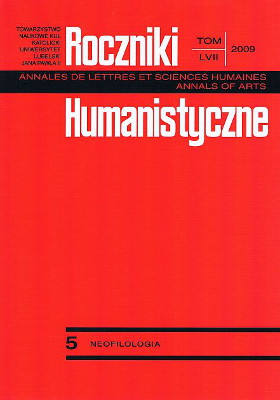The Role of Foreign (Second) Language Learning in the Development of Concept Understanding by Congenitally Blind Children. A Case Study of a Child Blind from Birth
Abstract
[Abstrakt tylko w j. polskim / Abstract only in Polish]
Rola uczenia się języka obcego w rozwoju rozumienia pojęć przez dzieci niewidome. Przypadek dziecka niewidomego od urodzenia
Artykuł stawia sobie za cel analizę wpływu uczenia się języka obcego na kompetencje językowe w języku ojczystym. Dziecko niewidome, przyswajając język obcy, uzupełnia braki w wiedzy, rozszerza swój światopogląd oraz uczy się interakcji z rówieśnikami. Język obcy pełni zatem rolę kompensacyjną w stosunku do języka macierzystego. Źródłem powyższych hipotez jest obserwacja procesu akwizycji języka angielskiego przez dziecko niewidome od urodzenia. Opisany przypadek pokazuje, że po okresie dwóch lat bezpośredniej ekspozycji na język obcy chłopiec uzyskał lepsze wyniki w ankiecie sprawdzającej rozumienie pojęć, przede wszystkim pojęć wizualnych i przestrzennych.
References
Brambring, M. (2007). Lehrstunden eines blinden Kindes. München: Verlag.
Byrne, R.W. and Salter, E. (1983). Distances and directions in cognitive maps of the blind. Canadian Journal of Psychology, 31, 293-299.
Carroll, J.B. (1962). The prediction of success in intensive foreign language training. In Glaser, R. (Ed.) Training Research and education. Pittsburgh: University of Pittsburgh.
Caton, H. (1977). The development and evaluation of a tactile analog to the Boehm test of basic concepts, form A. Visual Impairment and Blindness, 71, 382-386.
Couper, H. (1996). Teaching modern languages to visually impaired children. Language Learning Journal, 13, 6-9
Cratty, B.J. and Sams, T.A. (1968). The body-image of blind children. New York: American Foundation for the Blind.
Cutsforth, T.D. (1951). The blind in schools and society. New York: American Foundation for the Blind.
Grzegorzewska, M. (1964). Zjawisko kompensacji u niewidomych i głuchych. In Wybór Pism. Warszawa: PWN.
Harrison, F. and Crow, M. (1993). Living and learning with congenitally blind children. Canada: University of Toronto.
Hatwell, Y. (1985). Piagetian reasoning and the blind. New York: American Foundation for the Blind.
Klimasiński, K. (1989). Organizacja czynności poznawczych przy głębokim defekcie wzroku. Kraków: UJ.
Landau, B. and Gleitman, L.R. (1985). Language and experience. Evidence from the blind child. London: Harvard University Press.
Marek, B. (1999), A Blind Child in an English Language Classroom. Network. A Journal for English Language Teacher Education. Vol. 2 No. 1 Omnibus and The British Council.
Marek, B.. (2005). Learning from experience. Pomoce dydaktyczne i środki techniczne w nauczaniu osób niewidomych i słabowidzących. In B. Harań (Ed.) Teaching foreign languages to disabled students. Siedlce: Wydawnictwo Akademii Podlaskiej.
Mikołajczak-Matyja, N. (2008). Hierarchiczna struktura leksykonu umysłowego. Relacje semantyczne w leksykonie widzących i niewidomych użytkowników języka. Poznań: Wydawnictwo Naukowe UAM.
Millar, S. (1994). Understanding and Representing Space. Oxford: Oxford University Press.
Nikolic, T. (1986). Teaching a foreign language in schools for blind and visually impaired children. Journal of Visual Impairment and Blindness, 81, 62-66.
Norris, M., Spaulding, P.J. and Brodie, F.H. (1957). Blindness in children. Chicago: University of Chicago Press
Perez-Pereira and Conti-Ramsden. (1999). Language development and social interaction in blind children. Hove and New York: Psychology Press.
Piskorska, A. (2008). Concepts reflecting aesthetic judgments in blind children. In E. Mioduszewska and A. Piskorska (Eds.) Relevance Round Table. Warszawa: Warsaw University Press.
Pring, L. (2008). Psychological characteristics of children with visual impairments: learning, memory and imagery. British Journal of Visual Impairment 26 (2), 159-169.
Rosel, J. (2005). Verbalism in the narrative language of children who are blind and sighted. Journal of Visual Impairment and Blindness, 99, 413-425.
Sparks, R., Ganschow, L., Pohlman, J., Skinner, S., and Artzer, M. (1992). The effect of multisensory structured language instruction on native language and foreign language aptitude skills of at-risk high school foreign language learners. Annals of Dyslexia, 42, 25-53.
Sperber, D. and Wilson D. (1986). Relevance. London: Basil Blackwell.
Vygotsky, L. (1934). Thought and language. Cambridge, Massachusetts, London: The MIT Press.
Walthes, R. (2007). Tyflopedagogika. Gdańsk: Gdańskie Wydawnictwo Psychologiczne.
Warren, D. (1994). Blindness and children. An individual difference approach. Cambridge: Cambridge University Press.
Wyver, S.R., Markham R. and Hlavacek, S. (2000). Inferences and word associations of children with visual impairments. Journal of Visual Impairment and Blindness 94, 204-217.
Copyright (c) 2009 Roczniki Humanistyczne

This work is licensed under a Creative Commons Attribution-NonCommercial-NoDerivatives 4.0 International License.





